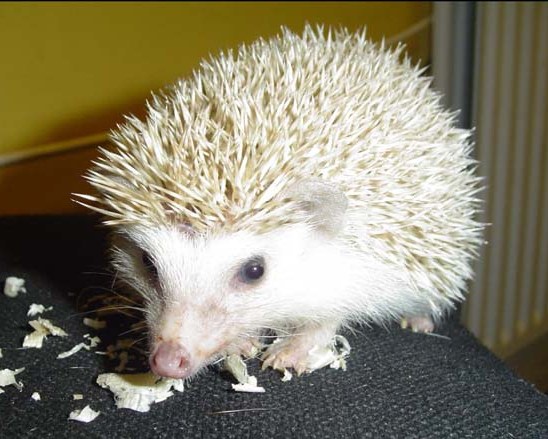
North African hedgehog, or Algerian hedgehog (Atelerix algirus)
Phylum —chordata
Class — mammalia
Order — eulipotyphla
Family — erinaceidae
Genus— atelerix
Appearance
The North African hedgehog closely resembles the European hedgehog but there are several distinct differences between the two species. The North African hedgehog tends to be smaller than its European counterpart, measuring between 20 and 25 cm (7.9 and 9.8 in) long and weighing up to 650 grams. However, it is larger than the other African species of hedgehogs and has a longer snout and longer legs, making it a faster runner. Its face is light in color, usually appearing to be white, and the legs and head are brown. The underbelly of this animal can vary in color and is often either brown or white. Its ears are highly visible on the head of the animal and are large. The body is covered in soft spines, which are mostly white with darker banding.
Habitat
North African hedgehogs are native to the northern regions of Africa from Morocco to Libya. They have also been introduced to nearby areas, including the southern, mountainous regions of Spain, France, and the islands off the coast of Africa, such as the Canary Islands and the Balearics.
Behavior
This species is difficult to study in the field because it is nocturnal. Like most hedgehogs, it is most likely solitary. When threatened, it curls into a ball and displays its spiny exterior to deter predators.
Diet
North African hedgehogs are generalist omnivores. They forage at night for arthropods, small vertebrates, carrion, fungi, and other available foods.
Reproduction
The gestation period of the North African hedgehog ranges from 30 to 40 days, and the litter size is between three and 10 hoglets. Two litters are often born in a season October to March. The hoglets are born with hairless, pinkish skin as well as small, soft spines, which are later shed once the hedgehog acquires its harder, stiffer set of quills at around four weeks of age; and generally weigh between 12 and 20 grams. This species reaches sexual maturity at eight to ten weeks of age and does not mate for life, that is this hedgehog does not participate in pair bonding.
Little is known about the lifespan of Atelerix algirus. It is expected to follow trends seen in other hedgehogs of its size. If so, the expected lifespan would be between 3 and 7 years in the wild and 8 to 10 years in captivity.
In captivity
These solitary animals prefer to be housed alone and may fight if kept with other hedgehogs. They seem to tolerate different types of pets in the house.
Active hedgehogs need room to explore; a bare minimum of two- to three-square-feet of cage space is sufficient (though bigger is always better). Any type of cage will work but avoid wire floors and make sure the spacing for wire-sided cages is 1 inch or smaller; you do not want your pet to squeeze through and escape. Large aquariums and even modified plastic storage bins with ventilation holes can also serve as hedgehog enclosures.
Aspen shavings or recycled paper alternatives make great bedding as do kiln-dried pine. But avoid cedar shavings, as the scent can be toxic to small mammals. Some North African hedgehog owners use indoor-outdoor carpeting or fleece fabric to line the cage instead of using loose bedding material. If you choose this bedding, make sure to clip loose threads that can tangle up your hedgehog and always have a backup for easy cleaning and replacing.
Unlike cats, hedgehogs do not tend to use litter pans, so expect to do a lot of cleaning. Provide a cardboard box or box-like enclosure inside the cage so your pet can hide and sleep comfortably.
Buy an open-sided, solid-surface wheel that's large enough (preferably bigger than 10 inches) to allow room for your hedgehog to run in place.
High-quality cat food—supplemented with mealworms, crickets, and other treats—used to be the go-to food choice for pet hedgehogs. Nowadays, the pet industry sells high-quality hedgehog food that provides the exact nutrients your prickly pet needs. If you choose to feed it cat food, make sure it is a grain-free variety.
Being that hedgehogs are nocturnal animals, you will need to feed it at night when it is most active. Scheduled evening feedings are your best bet, once or twice a night. Give it food in the early evening and again in the late evening, if you are still awake. Although most hedgehogs are fine with one feeding per day.
Hedgehogs also like chasing and eating crickets (which should also be gut-loaded). This action mimics their foraging efforts in the wild and provides mental stimulation for captive hedgehogs. Provide small amounts of hard-boiled egg, baby food, or fruit as occasional treats.
Supply water in either a water bottle with a metal tip for drinking or in a small bowl. Some young pets may need both until they get used to using the bottle. Whatever you choose, make sure to change your hedgehog's water daily and check that the bottle tip is working.
 Russian
Russian
 English
English























